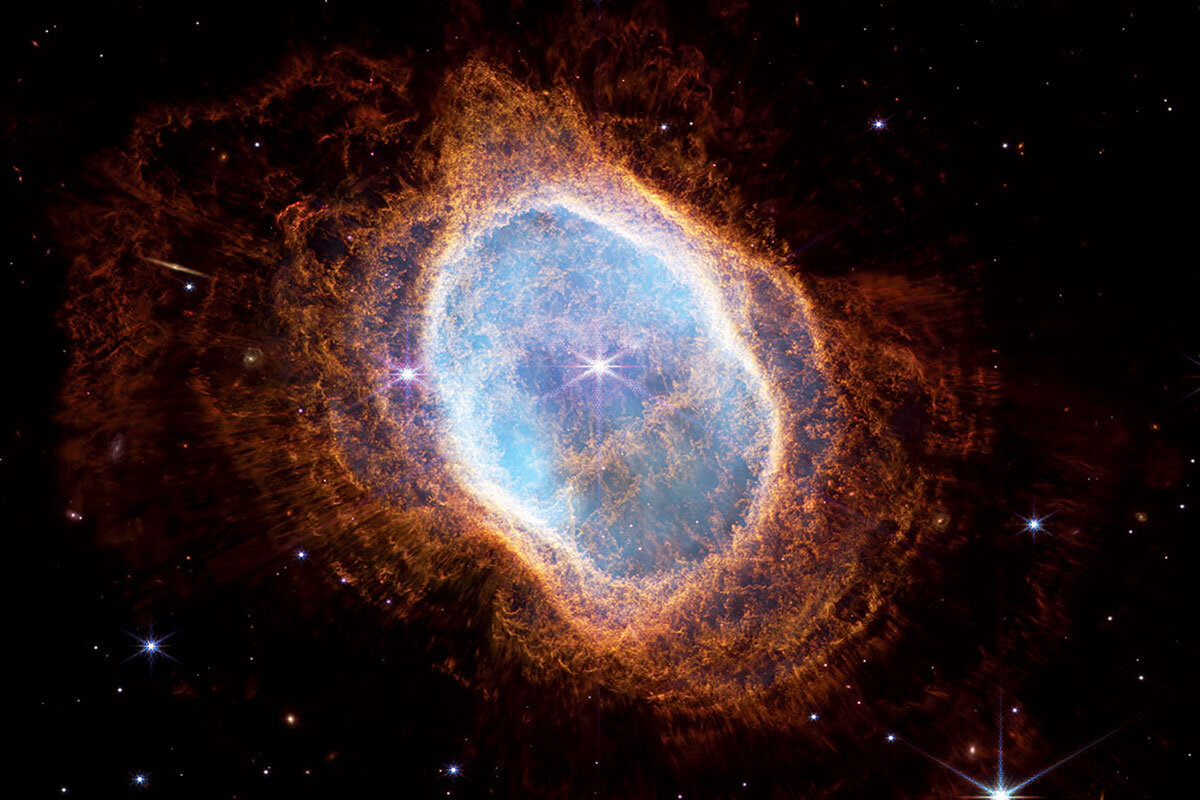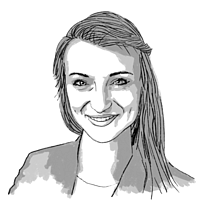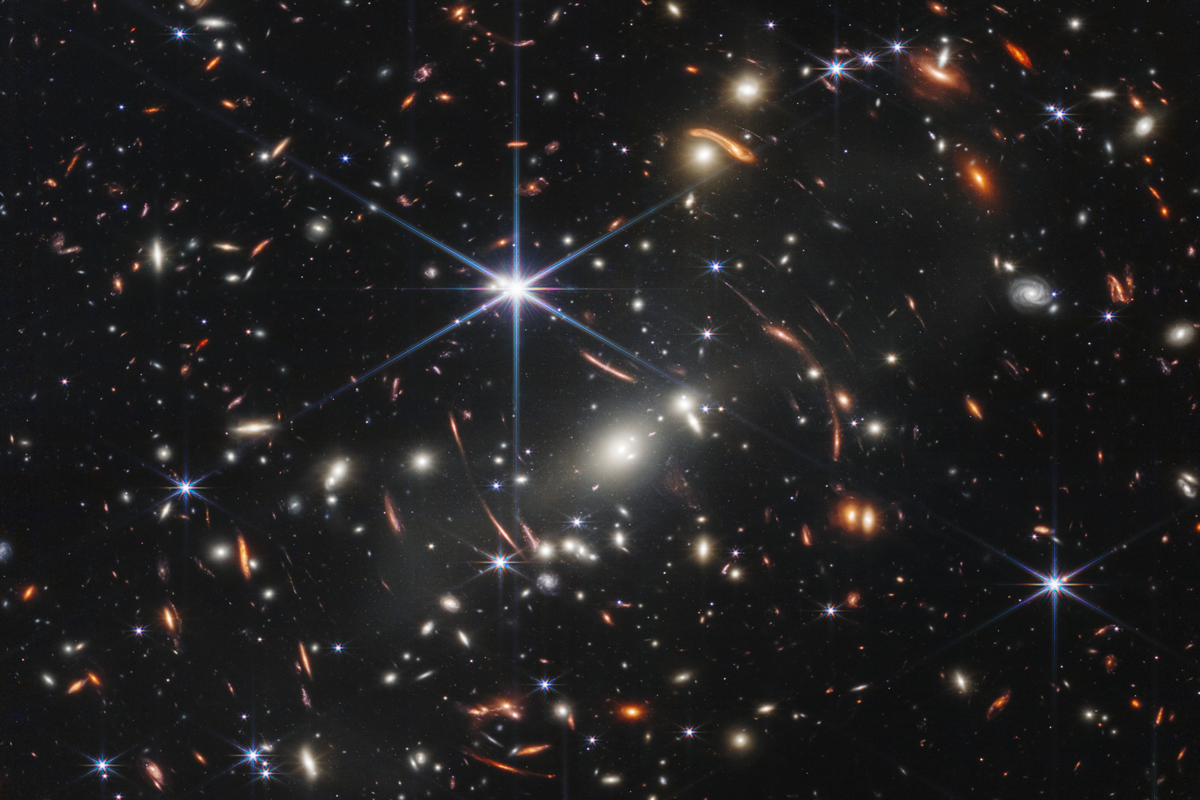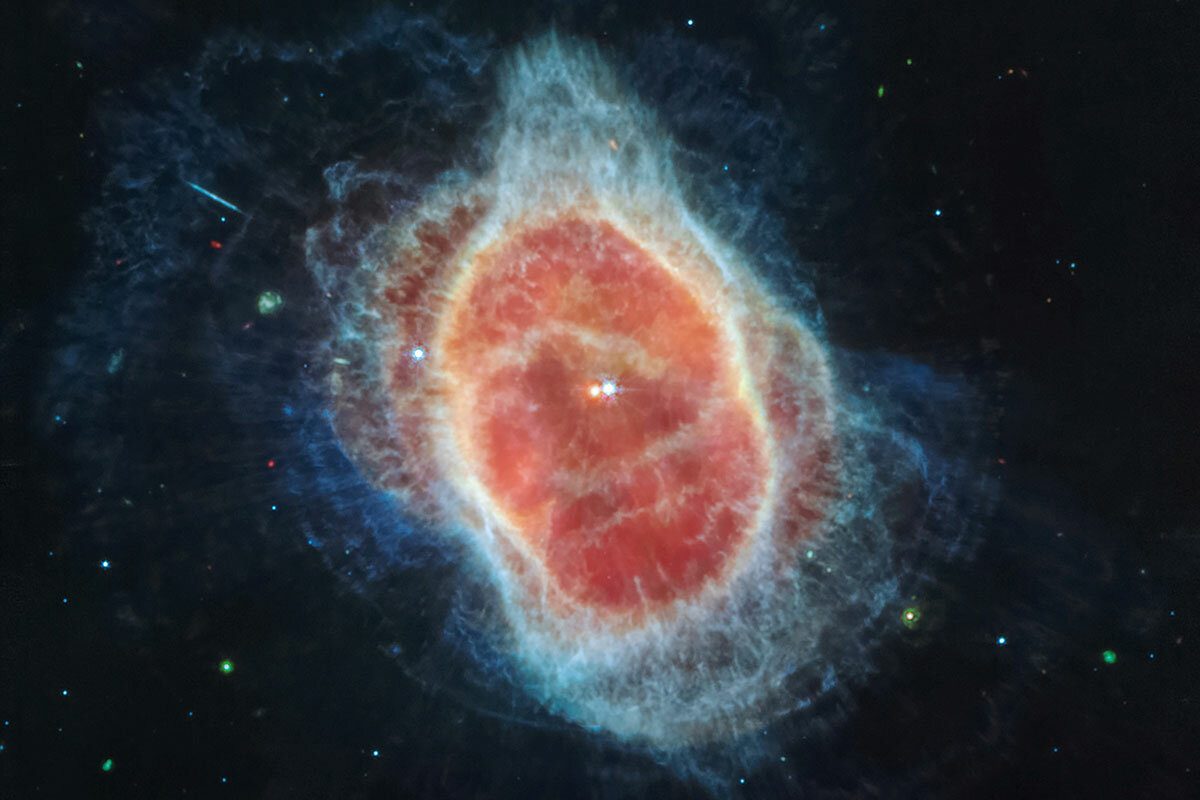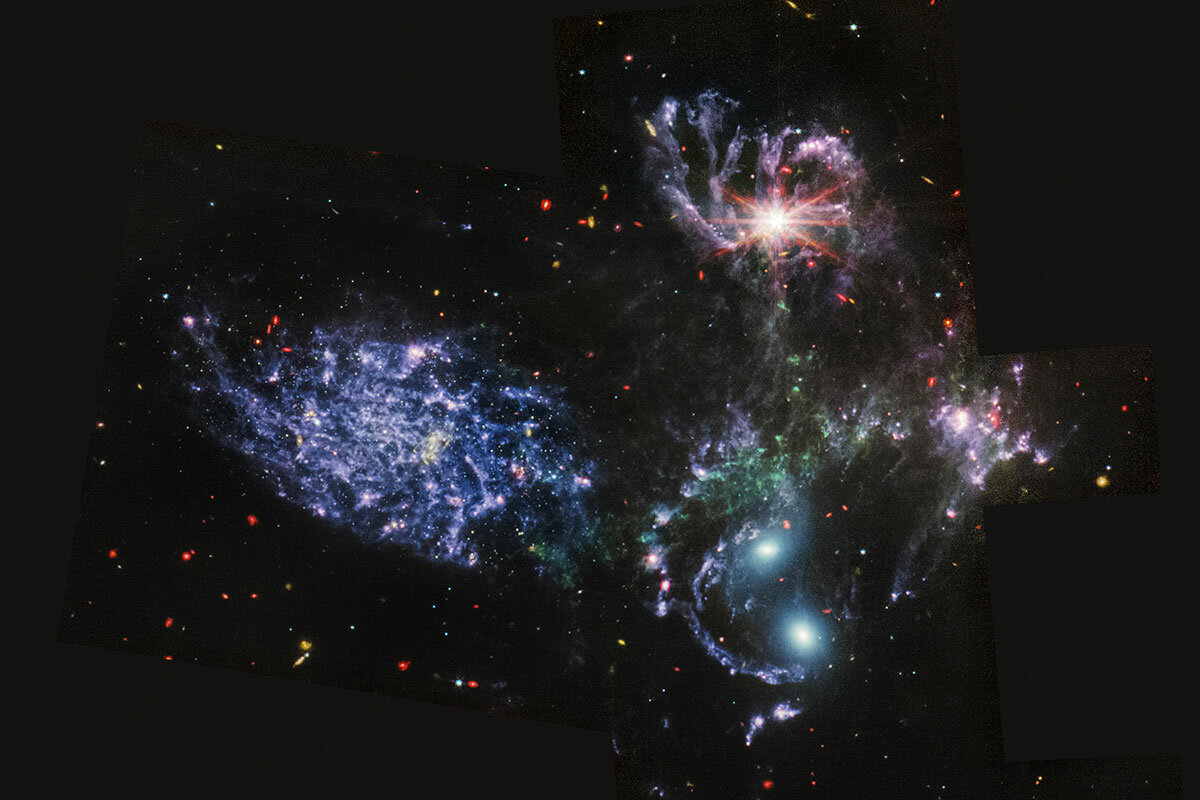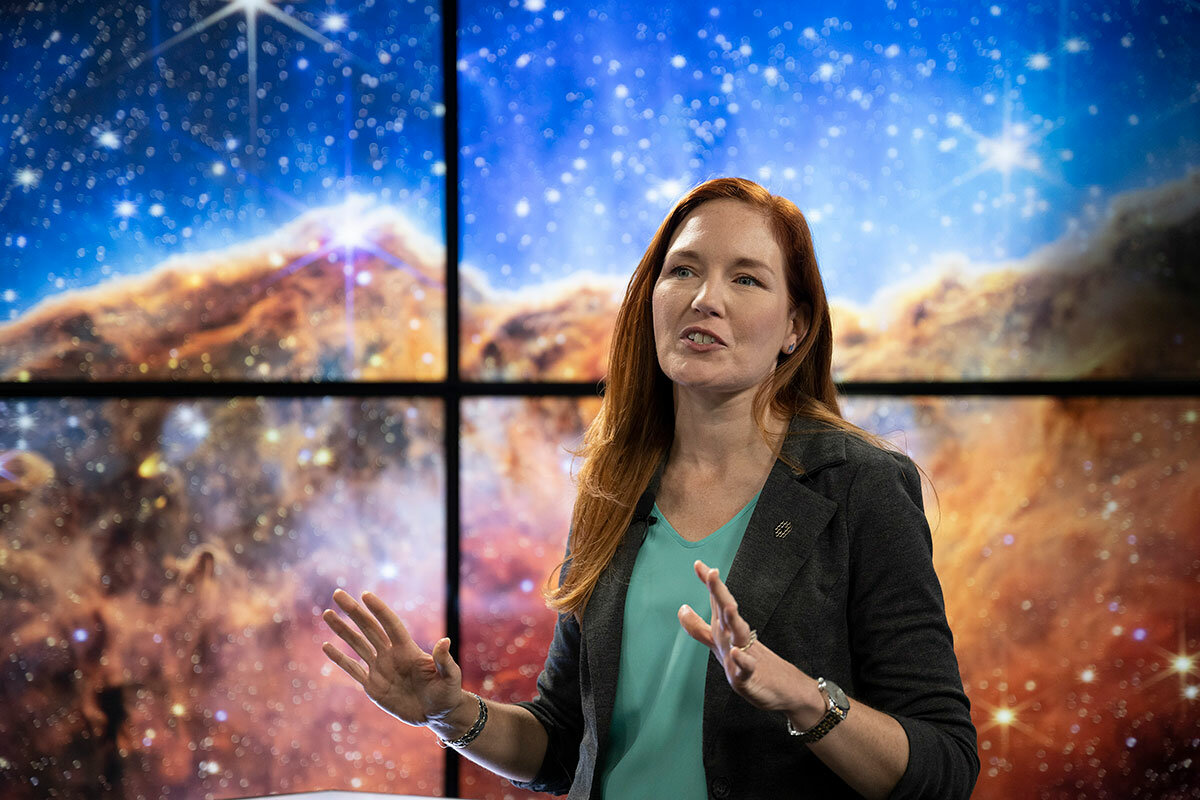Joy of discovery: How Webb telescope expands world’s sense of wonder
Loading...
Never before has humanity seen the cosmos like this.
Diamond-like stars dazzle in the foreground. Gas and dust billow out from cosmic collisions appearing to set the sky ablaze in rusty red tones. There are spiral galaxies, galaxies warped like pizza dough thrown in the air, merging galaxies, and galaxies appearing as faint red smudges so deep in the background that astronomers say the image captures the light they emitted perhaps 13.1 billion years ago.Ã˝
The first images from the James Webb Space Telescope (JWST) were released by NASA this week, revealing the most detailed view of the deepest parts of our universe yet and heralding a new era of astronomy. With its infrared “eyes,” the new space telescope has unveiled some of the earliest moments of the universe’s existence. This expanded view promises to reveal vital clues to cosmic mysteries that have long puzzled scientists.
Why We Wrote This
Bringing joy to viewers with their dazzling colors and contours, the first images from the James Webb Space Telescope are also a reflection of ingenuity – revealing a whole new layer of the cosmos.
In the excitement over this initial burst of images from the JWST, scientific ingenuity coincides with pure joy. We‚Äôve been literally star-struck as the photos render the unimaginably distant, up close and beautiful.Ã˝
“It’s fun to be able to see these baby pictures of the universe,” says Brant Robertson, who leads the Computational Astrophysics Research Group at the University of California, Santa Cruz, and who is involved in several major programs using the JWST to study galaxies in the early universe. “But it’s not just a picture. The key to unlocking that initial story, to be able to write the first pages of cosmic history for galaxy formation, is really being able to find these distant objects. The JWST can do that.”
Astronomers around the world are furiously digging into the first batch of data from the JWST released along with the images. The findings that they publish over the next few months could fundamentally shift how we understand our universe. But it is the photos themselves that can inspire imaginative speculation and drive humanity‚Äôs endeavors to understand the deepest reaches of the cosmos.Ã˝
“People wonder what makes a good astronomer,” Dr. Robertson says. Is it that you have a mind for math, or perhaps are drawn to physics? “Honestly, I think it’s a good imagination. You have to try to envision what the universe was like, at vast distances, in environments that are completely different than how the sun and the Earth or the Milky Way is. How can you put your mind into a place that you’ve never seen before? That’s why these pictures are so important to astronomers.”
That‚Äôs exactly how Jacqueline Faherty found her way to becoming an astrophysicist.Ã˝Now¬Ýsenior education manager and a senior astrophysicist at¬Ýthe American Museum of Natural History in New York, she credits an early encounter with a cosmic photo for setting her on her professional path.
When Dr. Faherty was 18, she saw an image taken by the Hubble Space Telescope of supermassive star¬Ý. The photo shows gas and dust clouds billowing out from the eruptive star system. At the time, she remembers thinking to herself, ‚Äú‚ÄòWait a second.Ã˝That‚Äôs out there? What is that? I want to do that. I‚Äôm going to figure this out.‚Äô And I never looked back.‚Äù¬Ý
Now, Dr. Faherty is preparing to make her own observations using the new space telescope. She studies the coldest objects that emerge from the star formation process, and is going to be turning the JWST‚Äôs infrared detectors toward those weird worlds to examine the content of their atmospheres, among other details. It‚Äôs possible, Dr. Faherty says, that the JWST could reveal clues as to whether extraterrestrial life might exist on one of those cold, cold worlds.Ã˝
Tracking infrared light
The JWST was designed to be able to look at the coldest ‚Äì and at the oldest ‚Äì things in the universe. Astronomers largely detect celestial objects from the radiation they emit, with telescopes tuned to pick up signals at specific wavelengths. Hotter objects tend to emit radiation with shorter wavelengths, such as ultraviolet light, while cooler objects emit infrared light, which is not visible to the human eye.Ã˝
Objects farther away from us also tend to appear in the infrared, as the distance causes their light’s wavelength to shift to be longer. And, as the universe is expanding, the farthest objects that we can see are also the oldest, with their light taking billions of years to reach the JWST’s detectors.
‚ÄúThat was what we built the telescope to do,‚Äù said Jane Rigby, operations project scientist for the JWST and an astrophysicist in the Observational Cosmology Lab at NASA‚Äôs Goddard Space Flight Center in Greenbelt, Maryland. The first ¬ÝNASA revealed, which contains galaxy cluster SMACS 0723, looks deep into the universe. In it, there are galaxies a few billion years old in the foreground and faint red ones ‚Äúlittered like jewels‚Äù in the background appearing to us as they did 13 billion years ago.
The new JWST images didn‚Äôt just reveal a detailed first look at the early days of the universe, however. The new space telescope also turned its infrared ‚Äúeyes‚Äù on objects closer to our corner of the cosmos to illuminate details that were hidden to astronomers previously looking at other wavelengths, revealing¬Ý¬Ýof the cosmos to humanity.
Images that show the advance from Hubble
The Hubble Space Telescope, which began its tenure 32 years ago, focused largely on the optical wavelengths of light. Dubbed ‚Äúthe people‚Äôs telescope,‚Äù Hubble brought images of the cosmos into popular culture and sparked curiosity in many, like Dr. Faherty. One of the most famous images snapped by Hubble was of the ‚ÄòCosmic Cliffs‚Äô of the Carina Nebula, which is roughly 7,600 light-years away from us. (Eta Carina is also in this nebula.) The hazy glow of gas and dust that make up the nebula are stark against a milky sky dotted with the sparkle of stars in the¬Ý. But the¬Ý¬Ýof the ‚ÄòCosmic Cliffs‚Äô is not hazy. The edges of the nebula are crisp, many more glittering stars appear, and the gas and dust of this stellar nursery appears to have distinct mountains and valleys.Ã˝
The JWST also captured¬Ý¬Ýwhen observations in both the near-infrared and the mid-infrared ranges revealed details about the two stars locked in a tight dance in the Southern Ring Nebula, which sits about 2,500 light-years away.Ã˝
In a galaxy group called ‚ÄúStephan‚Äôs Quintet,‚Äù the JWST captured the¬Ý¬Ýof two of the five galaxies. The space telescope also unveiled the signature of an active black hole at the heart of one of the galaxies, which offers scientists a chance to study how supermassive black holes consume the material around them in detail.Ã˝
Water on an exoplanet
The four images were not all that was revealed from the JWST‚Äôs initial discoveries this week. NASA also announced that the space telescope captured the signature of water in the atmosphere of a giant exoplanet called¬Ý, which is roughly 1,150 light-years away from Earth. Scientists also found evidence that there are clouds and haze in¬Ýthat¬Ýworld‚Äôs atmosphere, demonstrating the space telescope‚Äôs ability to peer into the chemistry of exoplanets in the quest to find other habitable worlds.
The JWST isn‚Äôt the first space telescope¬Ýto peer¬Ýat the infrared. The Spitzer Space Telescope, which¬Ýended operations in 2020, also looked at that wavelength. While it was ‚Äúthe little engine that could, and did an enormous amount in infrared astronomy,‚Äù Dr. Faherty says, the JWST has a much better resolution than Spitzer to reveal details of objects that were previously invisible in the deepest parts of the universe.
Astronomers are already poring over the data and images, Dr. Robertson says. They‚Äôre using the images not just for inspiration, but as a tool to contextualize and confirm discoveries they‚Äôre making in the data.Ã˝
Roles for citizens
Dr. Robertson himself has uploaded the images in a format that people can zoom in and interact with, and he of any scientific or non-scientific background to explore them. The majority of the is also available online, and he hopes that “young astronomers throughout the world can make discoveries in these images.”
With the JWST looking at all depths of the universe and all kinds of different celestial objects, there are many discoveries to be made. Dr. Faherty has already been collaborating with citizen scientists in her proposals for time using the JWST through her citizen science project .Ã˝
‚ÄúIf you get excited about JWST images, join a citizen science project,‚Äù she says, ‚ÄúBecause people like me will find a project for you, and you might find something.‚Äù¬Ý
Already, JWST images are finding their way to viewers that might not ordinarily be interested in astronomy, Dr. Faherty adds. In the future, “kids may very well remember when they saw JWST imagery show up on Instagram or TikTok,” she says. “In the era of social media, these images become amplified big time.”
Astronomers say to expect a lot more from the JWST, and soon.Ã˝
“The amazing thing about Webb is the speed at which we can churn out discoveries,” Dr. Rigby said during the NASA broadcast. With Hubble, imaging the deep field took two weeks of continuous work, but “With Webb, we took that image before breakfast,” she said. Everything that was revealed this week took only about a week of observation time with the JWST, she said. “We’re going to be doing discoveries like this every week.”



